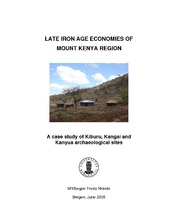Late iron age economies of Mount Kenya region A case study of Kiburu, Kangai and Kanyua archaeological sites
Master thesis
Permanent lenke
https://hdl.handle.net/1956/1859Utgivelsesdato
2006Metadata
Vis full innførselSammendrag
Earlier Iron Age investigations in Kenya concentrated on the Lake Victoria Basin and the coast of Kenya, mainly focusing on origins and technological aspects of iron, with brief statements on economies. The pioneering work on Iron Age in the Mt. Kenya region was part of the British Institute of East Africa “Bantu Studies Project” which was primarily established to conduct research related to Bantu speakers culture. During this project, both Kwale ware (a Bantu speakers pottery) and Gatung’ang’a/Maore pottery (makers unknown) were found in the same archaeological contexts in both Mt. Kenya region and North eastern Tanzania. Although it could not be ascertained that the same cultural groups made Gatung’ang’a and Kwale ware, it was generally assumed that Gatung’ang’a ware is a pottery of Bantu speakers. This innterpretation does not only have consequences on pottery chronology, and inhabitants of the region but also it has effectively obscured studies related to Iron Age economies of Mt. Kenya region since the economy of Bantu speakers is generally accepted as cultivation. I have demonstrated that, Gatung’ang’a pottery might not be a product of Bantu speakers using excavated archaeological materials from Kiburu, Kangai and Kanyua sites in Mt. Kenya region, and other Iron Age materials excavated earlier. In addition, I have used historical, oral and linguistic sources as complementary sources to indicate that Mt. Kenya region was occupied by communities that practiced both hunting and herding economies, and engaged in trade with the coast. I recommend that, in order to make more informed choices about the pottery and the economies of the Mt. Kenya region, further research and chronology of Mt. Kenya pottery should be established so that Gatung’ang’a pottery can be put in its rightful place. This will provide conclusive evidence on economies and inhabitants of the region. In addition, systematic surveys and excavations covering the 500-kilometer region between Mt. Kenya area and the coast would be an important contribution towards our understanding of early trade connection between the two regions.
Utgiver
The University of BergenOpphavsrett
Copyright the author. All rights reservedThe author
